Business Strategy and Role of HR 1 Assignment 2022
VerifiedAdded on 2022/10/06
|11
|2944
|15
Assignment
AI Summary
Contribute Materials
Your contribution can guide someone’s learning journey. Share your
documents today.
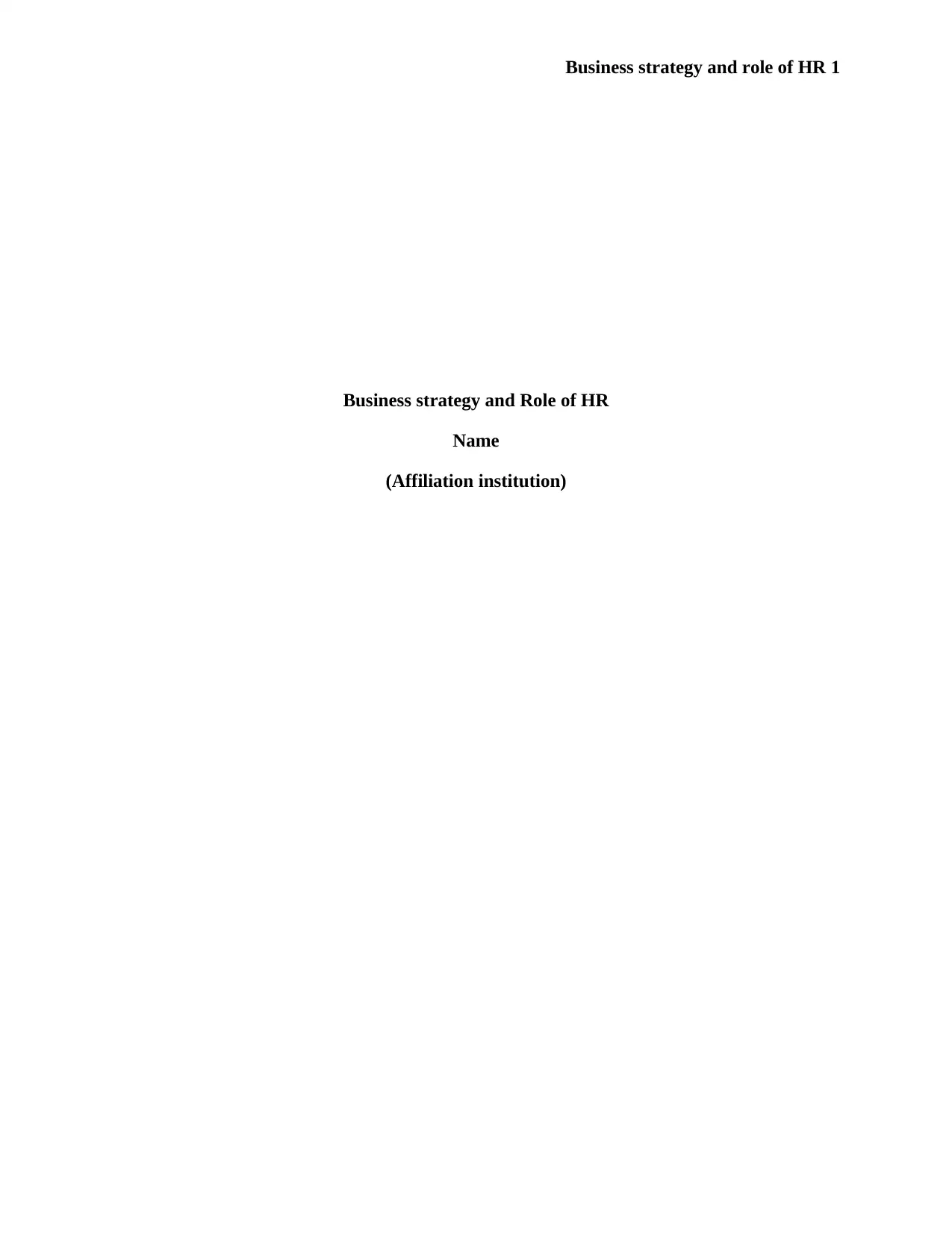
Business strategy and role of HR 1
Business strategy and Role of HR
Name
(Affiliation institution)
Business strategy and Role of HR
Name
(Affiliation institution)
Secure Best Marks with AI Grader
Need help grading? Try our AI Grader for instant feedback on your assignments.
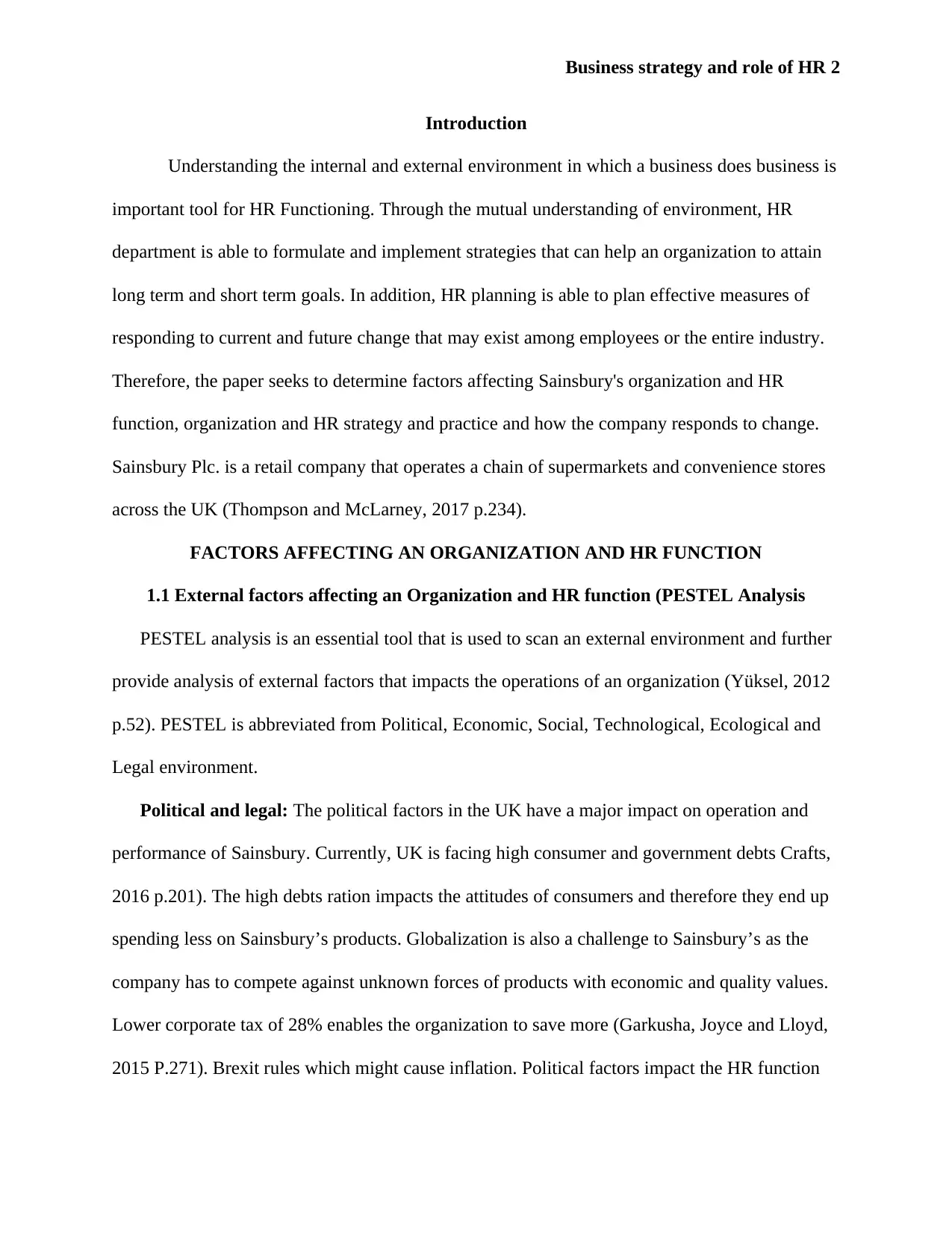
Business strategy and role of HR 2
Introduction
Understanding the internal and external environment in which a business does business is
important tool for HR Functioning. Through the mutual understanding of environment, HR
department is able to formulate and implement strategies that can help an organization to attain
long term and short term goals. In addition, HR planning is able to plan effective measures of
responding to current and future change that may exist among employees or the entire industry.
Therefore, the paper seeks to determine factors affecting Sainsbury's organization and HR
function, organization and HR strategy and practice and how the company responds to change.
Sainsbury Plc. is a retail company that operates a chain of supermarkets and convenience stores
across the UK (Thompson and McLarney, 2017 p.234).
FACTORS AFFECTING AN ORGANIZATION AND HR FUNCTION
1.1 External factors affecting an Organization and HR function (PESTEL Analysis
PESTEL analysis is an essential tool that is used to scan an external environment and further
provide analysis of external factors that impacts the operations of an organization (Yüksel, 2012
p.52). PESTEL is abbreviated from Political, Economic, Social, Technological, Ecological and
Legal environment.
Political and legal: The political factors in the UK have a major impact on operation and
performance of Sainsbury. Currently, UK is facing high consumer and government debts Crafts,
2016 p.201). The high debts ration impacts the attitudes of consumers and therefore they end up
spending less on Sainsbury’s products. Globalization is also a challenge to Sainsbury’s as the
company has to compete against unknown forces of products with economic and quality values.
Lower corporate tax of 28% enables the organization to save more (Garkusha, Joyce and Lloyd,
2015 P.271). Brexit rules which might cause inflation. Political factors impact the HR function
Introduction
Understanding the internal and external environment in which a business does business is
important tool for HR Functioning. Through the mutual understanding of environment, HR
department is able to formulate and implement strategies that can help an organization to attain
long term and short term goals. In addition, HR planning is able to plan effective measures of
responding to current and future change that may exist among employees or the entire industry.
Therefore, the paper seeks to determine factors affecting Sainsbury's organization and HR
function, organization and HR strategy and practice and how the company responds to change.
Sainsbury Plc. is a retail company that operates a chain of supermarkets and convenience stores
across the UK (Thompson and McLarney, 2017 p.234).
FACTORS AFFECTING AN ORGANIZATION AND HR FUNCTION
1.1 External factors affecting an Organization and HR function (PESTEL Analysis
PESTEL analysis is an essential tool that is used to scan an external environment and further
provide analysis of external factors that impacts the operations of an organization (Yüksel, 2012
p.52). PESTEL is abbreviated from Political, Economic, Social, Technological, Ecological and
Legal environment.
Political and legal: The political factors in the UK have a major impact on operation and
performance of Sainsbury. Currently, UK is facing high consumer and government debts Crafts,
2016 p.201). The high debts ration impacts the attitudes of consumers and therefore they end up
spending less on Sainsbury’s products. Globalization is also a challenge to Sainsbury’s as the
company has to compete against unknown forces of products with economic and quality values.
Lower corporate tax of 28% enables the organization to save more (Garkusha, Joyce and Lloyd,
2015 P.271). Brexit rules which might cause inflation. Political factors impact the HR function
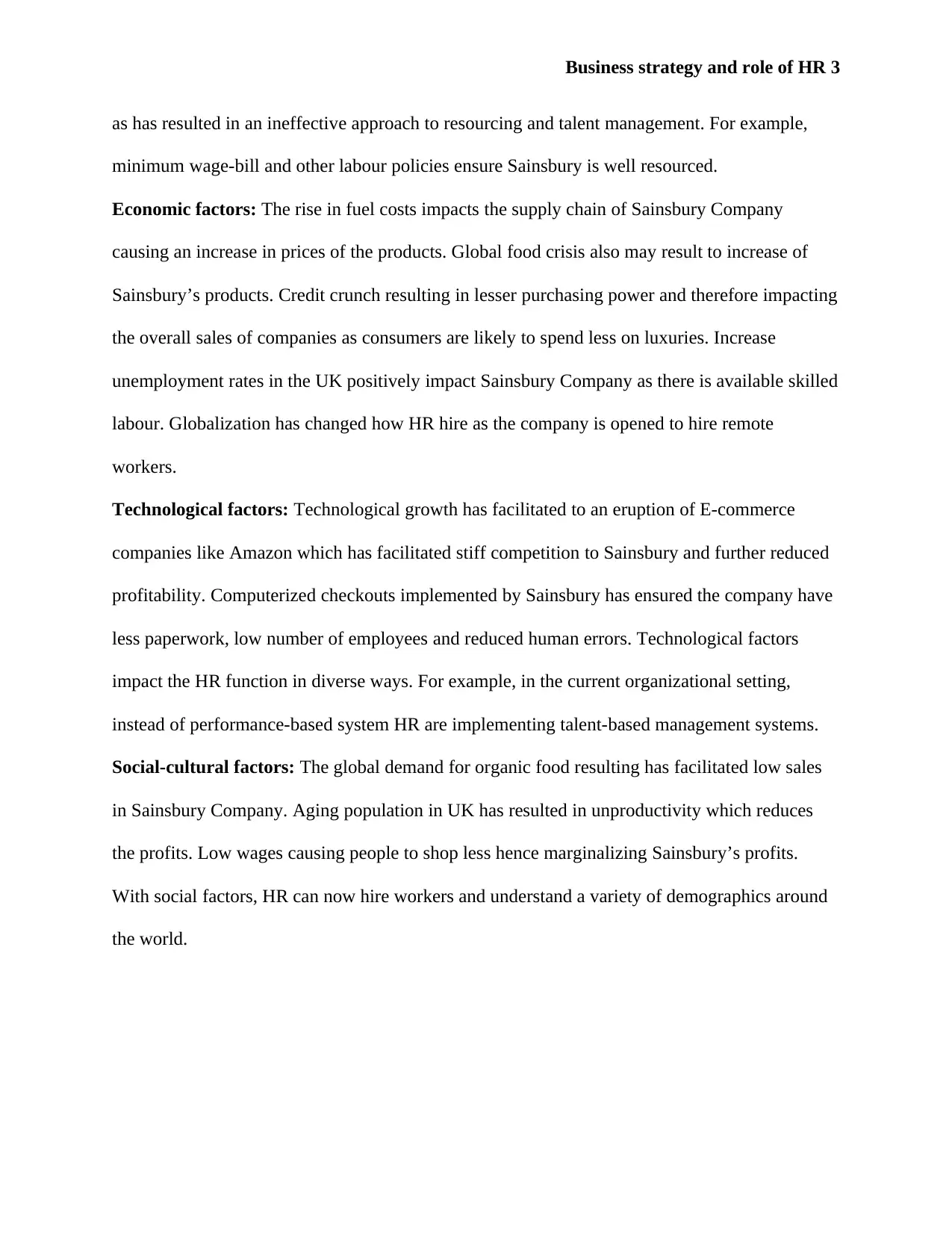
Business strategy and role of HR 3
as has resulted in an ineffective approach to resourcing and talent management. For example,
minimum wage-bill and other labour policies ensure Sainsbury is well resourced.
Economic factors: The rise in fuel costs impacts the supply chain of Sainsbury Company
causing an increase in prices of the products. Global food crisis also may result to increase of
Sainsbury’s products. Credit crunch resulting in lesser purchasing power and therefore impacting
the overall sales of companies as consumers are likely to spend less on luxuries. Increase
unemployment rates in the UK positively impact Sainsbury Company as there is available skilled
labour. Globalization has changed how HR hire as the company is opened to hire remote
workers.
Technological factors: Technological growth has facilitated to an eruption of E-commerce
companies like Amazon which has facilitated stiff competition to Sainsbury and further reduced
profitability. Computerized checkouts implemented by Sainsbury has ensured the company have
less paperwork, low number of employees and reduced human errors. Technological factors
impact the HR function in diverse ways. For example, in the current organizational setting,
instead of performance-based system HR are implementing talent-based management systems.
Social-cultural factors: The global demand for organic food resulting has facilitated low sales
in Sainsbury Company. Aging population in UK has resulted in unproductivity which reduces
the profits. Low wages causing people to shop less hence marginalizing Sainsbury’s profits.
With social factors, HR can now hire workers and understand a variety of demographics around
the world.
as has resulted in an ineffective approach to resourcing and talent management. For example,
minimum wage-bill and other labour policies ensure Sainsbury is well resourced.
Economic factors: The rise in fuel costs impacts the supply chain of Sainsbury Company
causing an increase in prices of the products. Global food crisis also may result to increase of
Sainsbury’s products. Credit crunch resulting in lesser purchasing power and therefore impacting
the overall sales of companies as consumers are likely to spend less on luxuries. Increase
unemployment rates in the UK positively impact Sainsbury Company as there is available skilled
labour. Globalization has changed how HR hire as the company is opened to hire remote
workers.
Technological factors: Technological growth has facilitated to an eruption of E-commerce
companies like Amazon which has facilitated stiff competition to Sainsbury and further reduced
profitability. Computerized checkouts implemented by Sainsbury has ensured the company have
less paperwork, low number of employees and reduced human errors. Technological factors
impact the HR function in diverse ways. For example, in the current organizational setting,
instead of performance-based system HR are implementing talent-based management systems.
Social-cultural factors: The global demand for organic food resulting has facilitated low sales
in Sainsbury Company. Aging population in UK has resulted in unproductivity which reduces
the profits. Low wages causing people to shop less hence marginalizing Sainsbury’s profits.
With social factors, HR can now hire workers and understand a variety of demographics around
the world.
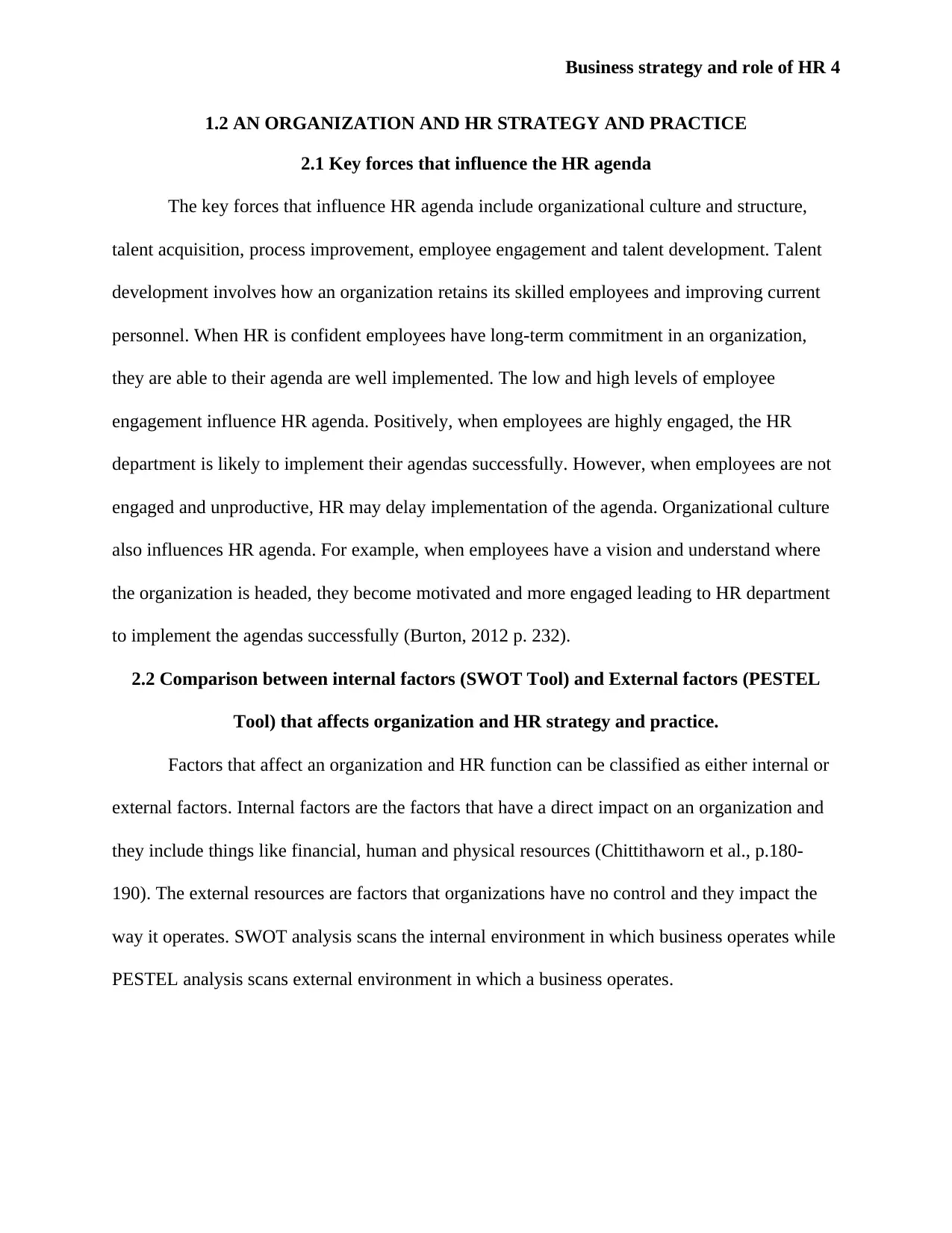
Business strategy and role of HR 4
1.2 AN ORGANIZATION AND HR STRATEGY AND PRACTICE
2.1 Key forces that influence the HR agenda
The key forces that influence HR agenda include organizational culture and structure,
talent acquisition, process improvement, employee engagement and talent development. Talent
development involves how an organization retains its skilled employees and improving current
personnel. When HR is confident employees have long-term commitment in an organization,
they are able to their agenda are well implemented. The low and high levels of employee
engagement influence HR agenda. Positively, when employees are highly engaged, the HR
department is likely to implement their agendas successfully. However, when employees are not
engaged and unproductive, HR may delay implementation of the agenda. Organizational culture
also influences HR agenda. For example, when employees have a vision and understand where
the organization is headed, they become motivated and more engaged leading to HR department
to implement the agendas successfully (Burton, 2012 p. 232).
2.2 Comparison between internal factors (SWOT Tool) and External factors (PESTEL
Tool) that affects organization and HR strategy and practice.
Factors that affect an organization and HR function can be classified as either internal or
external factors. Internal factors are the factors that have a direct impact on an organization and
they include things like financial, human and physical resources (Chittithaworn et al., p.180-
190). The external resources are factors that organizations have no control and they impact the
way it operates. SWOT analysis scans the internal environment in which business operates while
PESTEL analysis scans external environment in which a business operates.
1.2 AN ORGANIZATION AND HR STRATEGY AND PRACTICE
2.1 Key forces that influence the HR agenda
The key forces that influence HR agenda include organizational culture and structure,
talent acquisition, process improvement, employee engagement and talent development. Talent
development involves how an organization retains its skilled employees and improving current
personnel. When HR is confident employees have long-term commitment in an organization,
they are able to their agenda are well implemented. The low and high levels of employee
engagement influence HR agenda. Positively, when employees are highly engaged, the HR
department is likely to implement their agendas successfully. However, when employees are not
engaged and unproductive, HR may delay implementation of the agenda. Organizational culture
also influences HR agenda. For example, when employees have a vision and understand where
the organization is headed, they become motivated and more engaged leading to HR department
to implement the agendas successfully (Burton, 2012 p. 232).
2.2 Comparison between internal factors (SWOT Tool) and External factors (PESTEL
Tool) that affects organization and HR strategy and practice.
Factors that affect an organization and HR function can be classified as either internal or
external factors. Internal factors are the factors that have a direct impact on an organization and
they include things like financial, human and physical resources (Chittithaworn et al., p.180-
190). The external resources are factors that organizations have no control and they impact the
way it operates. SWOT analysis scans the internal environment in which business operates while
PESTEL analysis scans external environment in which a business operates.
Secure Best Marks with AI Grader
Need help grading? Try our AI Grader for instant feedback on your assignments.
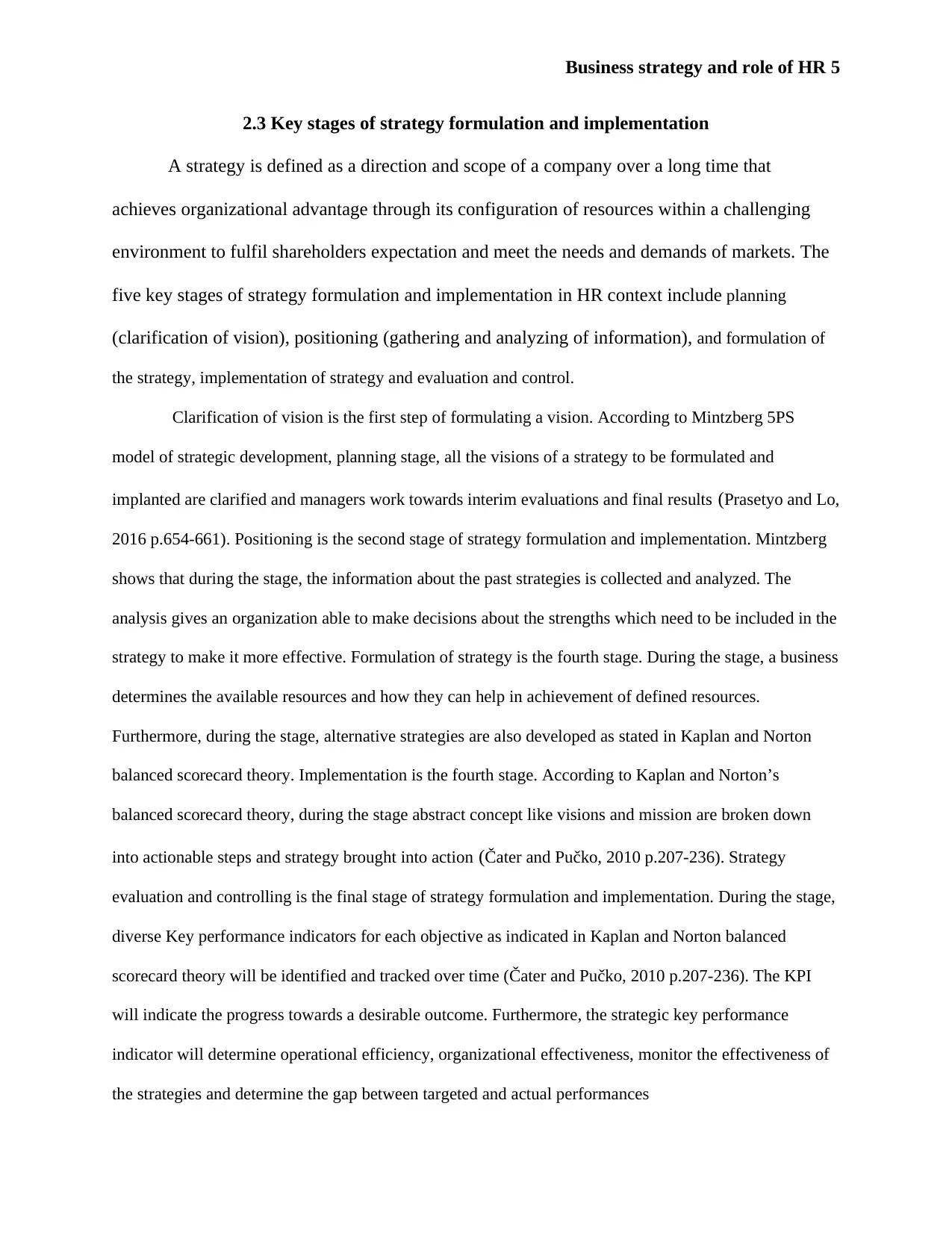
Business strategy and role of HR 5
2.3 Key stages of strategy formulation and implementation
A strategy is defined as a direction and scope of a company over a long time that
achieves organizational advantage through its configuration of resources within a challenging
environment to fulfil shareholders expectation and meet the needs and demands of markets. The
five key stages of strategy formulation and implementation in HR context include planning
(clarification of vision), positioning (gathering and analyzing of information), and formulation of
the strategy, implementation of strategy and evaluation and control.
Clarification of vision is the first step of formulating a vision. According to Mintzberg 5PS
model of strategic development, planning stage, all the visions of a strategy to be formulated and
implanted are clarified and managers work towards interim evaluations and final results (Prasetyo and Lo,
2016 p.654-661). Positioning is the second stage of strategy formulation and implementation. Mintzberg
shows that during the stage, the information about the past strategies is collected and analyzed. The
analysis gives an organization able to make decisions about the strengths which need to be included in the
strategy to make it more effective. Formulation of strategy is the fourth stage. During the stage, a business
determines the available resources and how they can help in achievement of defined resources.
Furthermore, during the stage, alternative strategies are also developed as stated in Kaplan and Norton
balanced scorecard theory. Implementation is the fourth stage. According to Kaplan and Norton’s
balanced scorecard theory, during the stage abstract concept like visions and mission are broken down
into actionable steps and strategy brought into action (Čater and Pučko, 2010 p.207-236). Strategy
evaluation and controlling is the final stage of strategy formulation and implementation. During the stage,
diverse Key performance indicators for each objective as indicated in Kaplan and Norton balanced
scorecard theory will be identified and tracked over time (Čater and Pučko, 2010 p.207-236). The KPI
will indicate the progress towards a desirable outcome. Furthermore, the strategic key performance
indicator will determine operational efficiency, organizational effectiveness, monitor the effectiveness of
the strategies and determine the gap between targeted and actual performances
2.3 Key stages of strategy formulation and implementation
A strategy is defined as a direction and scope of a company over a long time that
achieves organizational advantage through its configuration of resources within a challenging
environment to fulfil shareholders expectation and meet the needs and demands of markets. The
five key stages of strategy formulation and implementation in HR context include planning
(clarification of vision), positioning (gathering and analyzing of information), and formulation of
the strategy, implementation of strategy and evaluation and control.
Clarification of vision is the first step of formulating a vision. According to Mintzberg 5PS
model of strategic development, planning stage, all the visions of a strategy to be formulated and
implanted are clarified and managers work towards interim evaluations and final results (Prasetyo and Lo,
2016 p.654-661). Positioning is the second stage of strategy formulation and implementation. Mintzberg
shows that during the stage, the information about the past strategies is collected and analyzed. The
analysis gives an organization able to make decisions about the strengths which need to be included in the
strategy to make it more effective. Formulation of strategy is the fourth stage. During the stage, a business
determines the available resources and how they can help in achievement of defined resources.
Furthermore, during the stage, alternative strategies are also developed as stated in Kaplan and Norton
balanced scorecard theory. Implementation is the fourth stage. According to Kaplan and Norton’s
balanced scorecard theory, during the stage abstract concept like visions and mission are broken down
into actionable steps and strategy brought into action (Čater and Pučko, 2010 p.207-236). Strategy
evaluation and controlling is the final stage of strategy formulation and implementation. During the stage,
diverse Key performance indicators for each objective as indicated in Kaplan and Norton balanced
scorecard theory will be identified and tracked over time (Čater and Pučko, 2010 p.207-236). The KPI
will indicate the progress towards a desirable outcome. Furthermore, the strategic key performance
indicator will determine operational efficiency, organizational effectiveness, monitor the effectiveness of
the strategies and determine the gap between targeted and actual performances
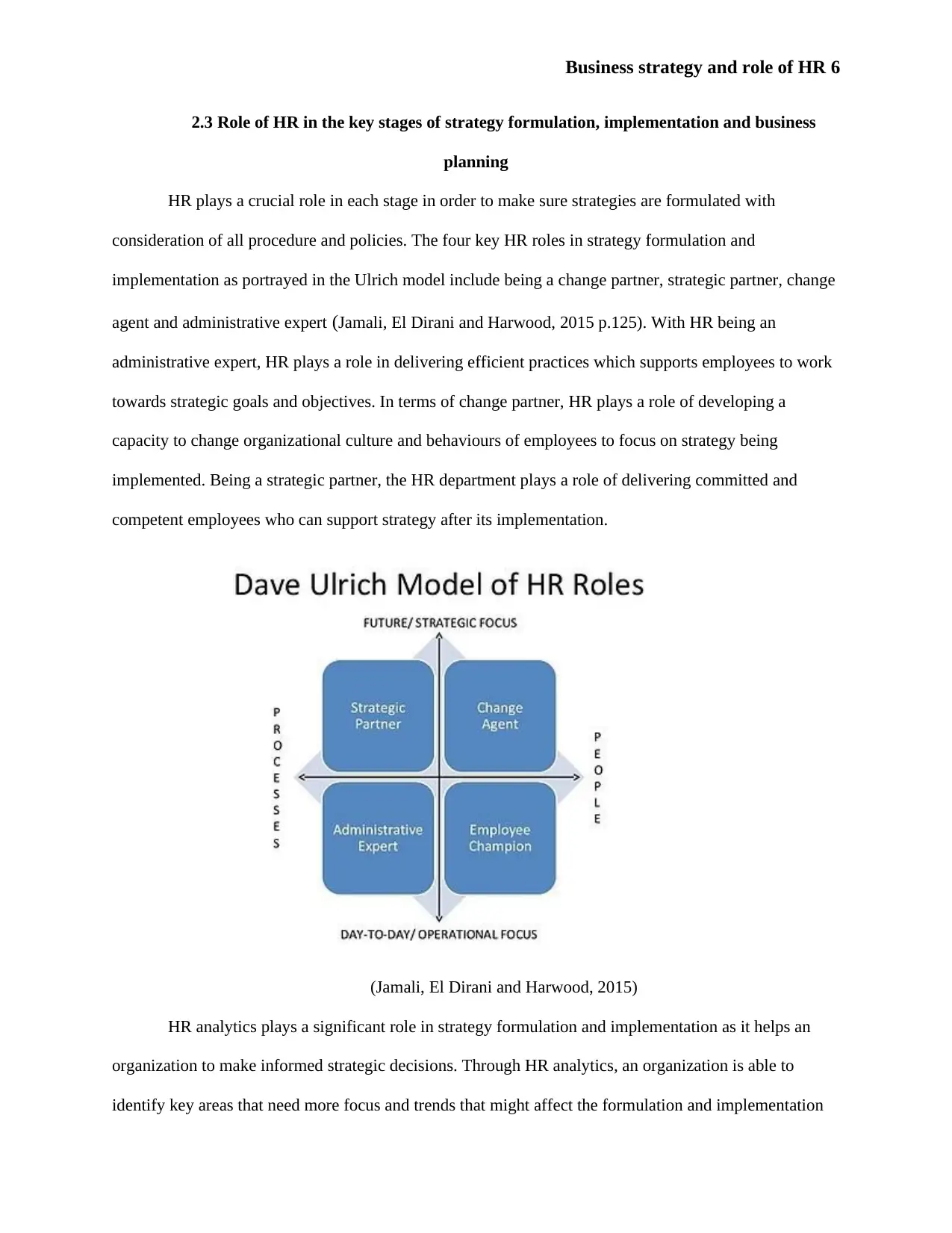
Business strategy and role of HR 6
2.3 Role of HR in the key stages of strategy formulation, implementation and business
planning
HR plays a crucial role in each stage in order to make sure strategies are formulated with
consideration of all procedure and policies. The four key HR roles in strategy formulation and
implementation as portrayed in the Ulrich model include being a change partner, strategic partner, change
agent and administrative expert (Jamali, El Dirani and Harwood, 2015 p.125). With HR being an
administrative expert, HR plays a role in delivering efficient practices which supports employees to work
towards strategic goals and objectives. In terms of change partner, HR plays a role of developing a
capacity to change organizational culture and behaviours of employees to focus on strategy being
implemented. Being a strategic partner, the HR department plays a role of delivering committed and
competent employees who can support strategy after its implementation.
(Jamali, El Dirani and Harwood, 2015)
HR analytics plays a significant role in strategy formulation and implementation as it helps an
organization to make informed strategic decisions. Through HR analytics, an organization is able to
identify key areas that need more focus and trends that might affect the formulation and implementation
2.3 Role of HR in the key stages of strategy formulation, implementation and business
planning
HR plays a crucial role in each stage in order to make sure strategies are formulated with
consideration of all procedure and policies. The four key HR roles in strategy formulation and
implementation as portrayed in the Ulrich model include being a change partner, strategic partner, change
agent and administrative expert (Jamali, El Dirani and Harwood, 2015 p.125). With HR being an
administrative expert, HR plays a role in delivering efficient practices which supports employees to work
towards strategic goals and objectives. In terms of change partner, HR plays a role of developing a
capacity to change organizational culture and behaviours of employees to focus on strategy being
implemented. Being a strategic partner, the HR department plays a role of delivering committed and
competent employees who can support strategy after its implementation.
(Jamali, El Dirani and Harwood, 2015)
HR analytics plays a significant role in strategy formulation and implementation as it helps an
organization to make informed strategic decisions. Through HR analytics, an organization is able to
identify key areas that need more focus and trends that might affect the formulation and implementation
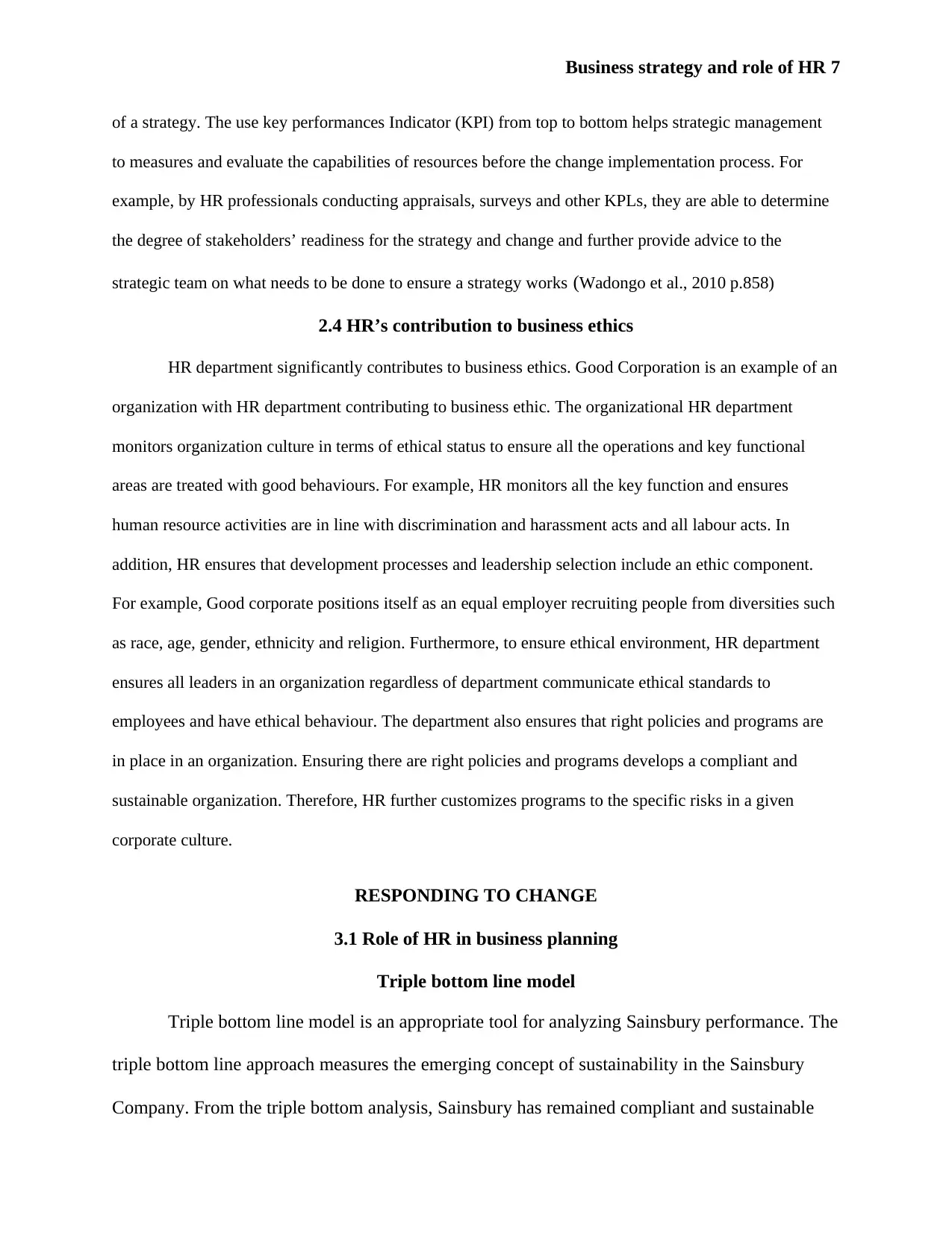
Business strategy and role of HR 7
of a strategy. The use key performances Indicator (KPI) from top to bottom helps strategic management
to measures and evaluate the capabilities of resources before the change implementation process. For
example, by HR professionals conducting appraisals, surveys and other KPLs, they are able to determine
the degree of stakeholders’ readiness for the strategy and change and further provide advice to the
strategic team on what needs to be done to ensure a strategy works (Wadongo et al., 2010 p.858)
2.4 HR’s contribution to business ethics
HR department significantly contributes to business ethics. Good Corporation is an example of an
organization with HR department contributing to business ethic. The organizational HR department
monitors organization culture in terms of ethical status to ensure all the operations and key functional
areas are treated with good behaviours. For example, HR monitors all the key function and ensures
human resource activities are in line with discrimination and harassment acts and all labour acts. In
addition, HR ensures that development processes and leadership selection include an ethic component.
For example, Good corporate positions itself as an equal employer recruiting people from diversities such
as race, age, gender, ethnicity and religion. Furthermore, to ensure ethical environment, HR department
ensures all leaders in an organization regardless of department communicate ethical standards to
employees and have ethical behaviour. The department also ensures that right policies and programs are
in place in an organization. Ensuring there are right policies and programs develops a compliant and
sustainable organization. Therefore, HR further customizes programs to the specific risks in a given
corporate culture.
RESPONDING TO CHANGE
3.1 Role of HR in business planning
Triple bottom line model
Triple bottom line model is an appropriate tool for analyzing Sainsbury performance. The
triple bottom line approach measures the emerging concept of sustainability in the Sainsbury
Company. From the triple bottom analysis, Sainsbury has remained compliant and sustainable
of a strategy. The use key performances Indicator (KPI) from top to bottom helps strategic management
to measures and evaluate the capabilities of resources before the change implementation process. For
example, by HR professionals conducting appraisals, surveys and other KPLs, they are able to determine
the degree of stakeholders’ readiness for the strategy and change and further provide advice to the
strategic team on what needs to be done to ensure a strategy works (Wadongo et al., 2010 p.858)
2.4 HR’s contribution to business ethics
HR department significantly contributes to business ethics. Good Corporation is an example of an
organization with HR department contributing to business ethic. The organizational HR department
monitors organization culture in terms of ethical status to ensure all the operations and key functional
areas are treated with good behaviours. For example, HR monitors all the key function and ensures
human resource activities are in line with discrimination and harassment acts and all labour acts. In
addition, HR ensures that development processes and leadership selection include an ethic component.
For example, Good corporate positions itself as an equal employer recruiting people from diversities such
as race, age, gender, ethnicity and religion. Furthermore, to ensure ethical environment, HR department
ensures all leaders in an organization regardless of department communicate ethical standards to
employees and have ethical behaviour. The department also ensures that right policies and programs are
in place in an organization. Ensuring there are right policies and programs develops a compliant and
sustainable organization. Therefore, HR further customizes programs to the specific risks in a given
corporate culture.
RESPONDING TO CHANGE
3.1 Role of HR in business planning
Triple bottom line model
Triple bottom line model is an appropriate tool for analyzing Sainsbury performance. The
triple bottom line approach measures the emerging concept of sustainability in the Sainsbury
Company. From the triple bottom analysis, Sainsbury has remained compliant and sustainable
Paraphrase This Document
Need a fresh take? Get an instant paraphrase of this document with our AI Paraphraser
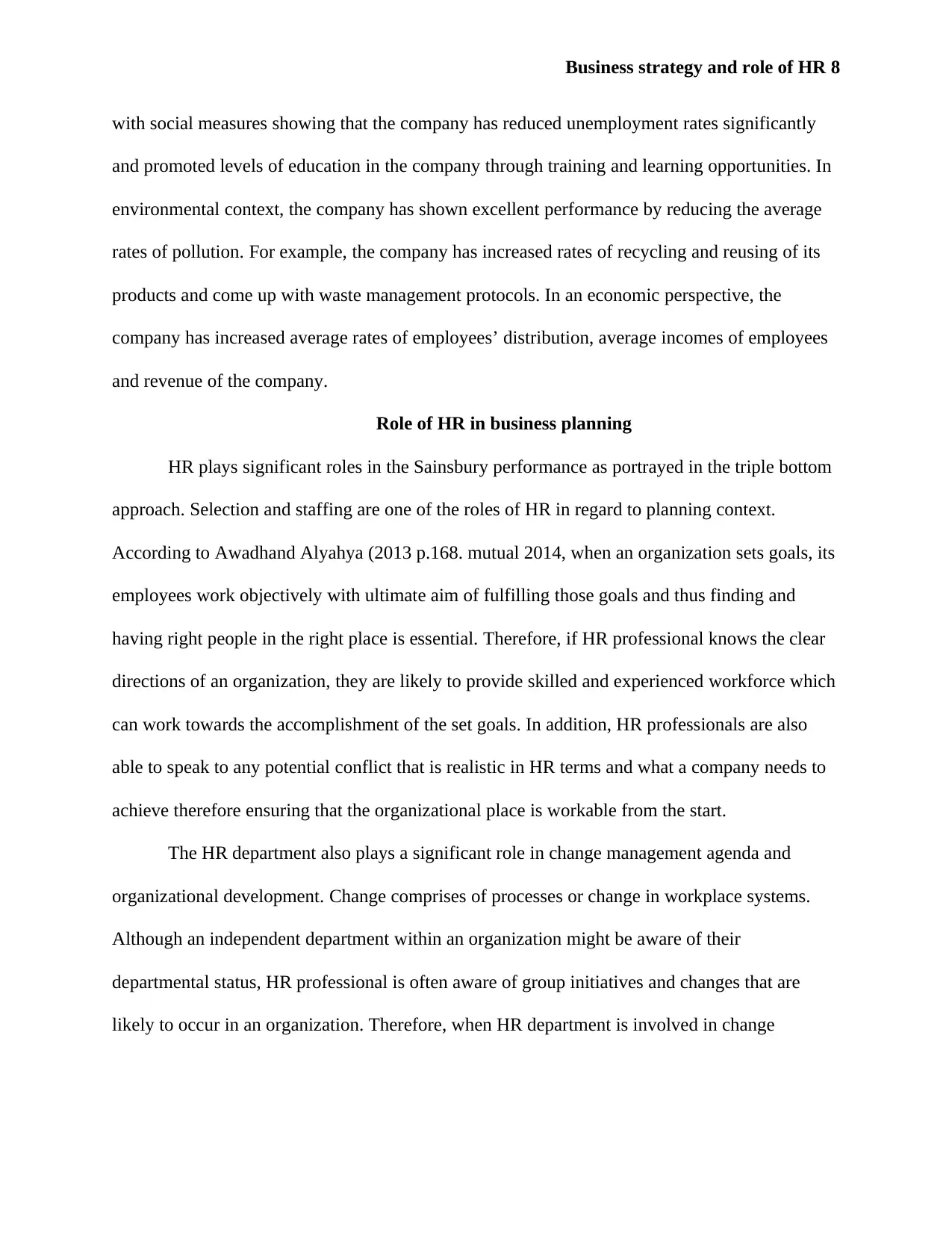
Business strategy and role of HR 8
with social measures showing that the company has reduced unemployment rates significantly
and promoted levels of education in the company through training and learning opportunities. In
environmental context, the company has shown excellent performance by reducing the average
rates of pollution. For example, the company has increased rates of recycling and reusing of its
products and come up with waste management protocols. In an economic perspective, the
company has increased average rates of employees’ distribution, average incomes of employees
and revenue of the company.
Role of HR in business planning
HR plays significant roles in the Sainsbury performance as portrayed in the triple bottom
approach. Selection and staffing are one of the roles of HR in regard to planning context.
According to Awadhand Alyahya (2013 p.168. mutual 2014, when an organization sets goals, its
employees work objectively with ultimate aim of fulfilling those goals and thus finding and
having right people in the right place is essential. Therefore, if HR professional knows the clear
directions of an organization, they are likely to provide skilled and experienced workforce which
can work towards the accomplishment of the set goals. In addition, HR professionals are also
able to speak to any potential conflict that is realistic in HR terms and what a company needs to
achieve therefore ensuring that the organizational place is workable from the start.
The HR department also plays a significant role in change management agenda and
organizational development. Change comprises of processes or change in workplace systems.
Although an independent department within an organization might be aware of their
departmental status, HR professional is often aware of group initiatives and changes that are
likely to occur in an organization. Therefore, when HR department is involved in change
with social measures showing that the company has reduced unemployment rates significantly
and promoted levels of education in the company through training and learning opportunities. In
environmental context, the company has shown excellent performance by reducing the average
rates of pollution. For example, the company has increased rates of recycling and reusing of its
products and come up with waste management protocols. In an economic perspective, the
company has increased average rates of employees’ distribution, average incomes of employees
and revenue of the company.
Role of HR in business planning
HR plays significant roles in the Sainsbury performance as portrayed in the triple bottom
approach. Selection and staffing are one of the roles of HR in regard to planning context.
According to Awadhand Alyahya (2013 p.168. mutual 2014, when an organization sets goals, its
employees work objectively with ultimate aim of fulfilling those goals and thus finding and
having right people in the right place is essential. Therefore, if HR professional knows the clear
directions of an organization, they are likely to provide skilled and experienced workforce which
can work towards the accomplishment of the set goals. In addition, HR professionals are also
able to speak to any potential conflict that is realistic in HR terms and what a company needs to
achieve therefore ensuring that the organizational place is workable from the start.
The HR department also plays a significant role in change management agenda and
organizational development. Change comprises of processes or change in workplace systems.
Although an independent department within an organization might be aware of their
departmental status, HR professional is often aware of group initiatives and changes that are
likely to occur in an organization. Therefore, when HR department is involved in change
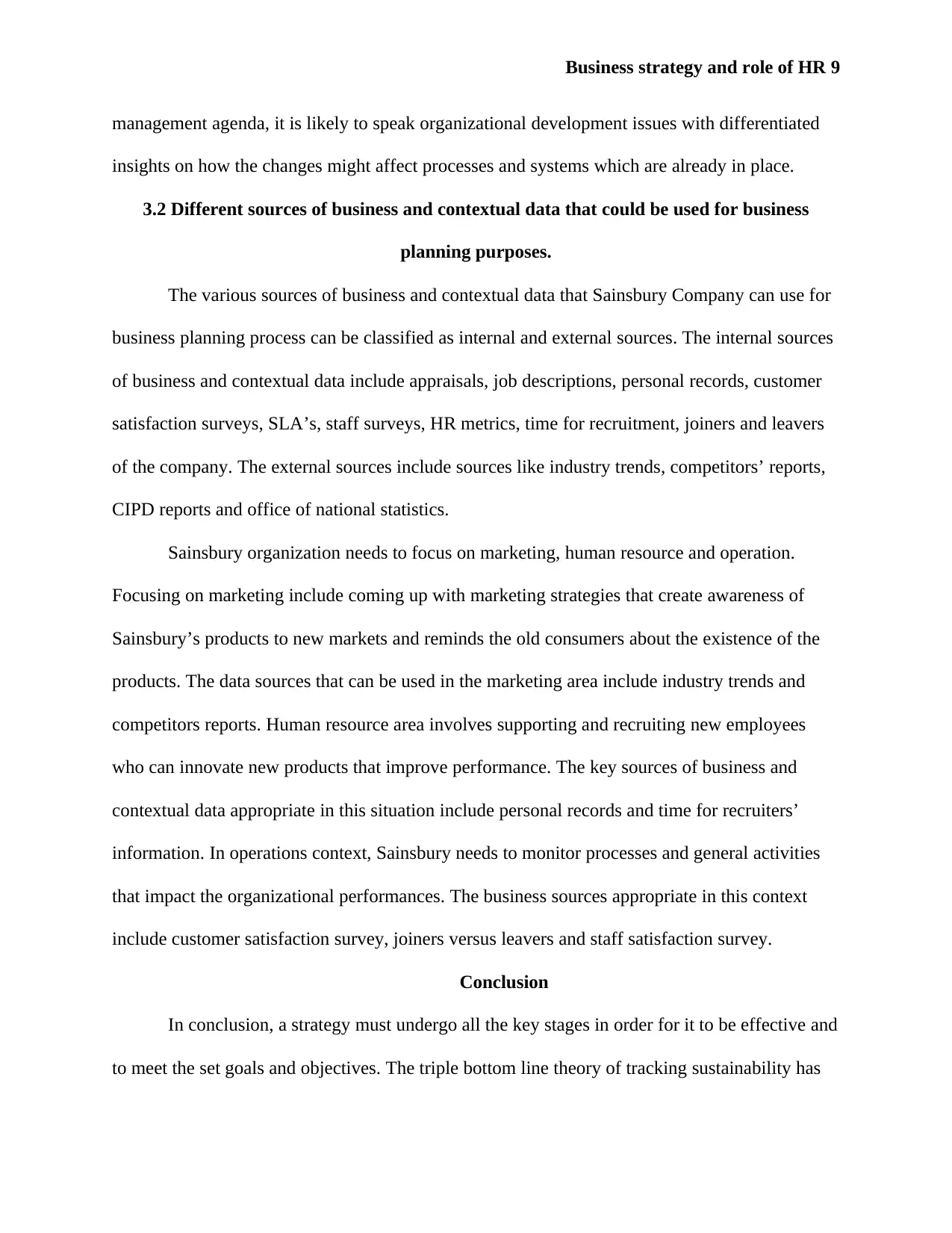
Business strategy and role of HR 9
management agenda, it is likely to speak organizational development issues with differentiated
insights on how the changes might affect processes and systems which are already in place.
3.2 Different sources of business and contextual data that could be used for business
planning purposes.
The various sources of business and contextual data that Sainsbury Company can use for
business planning process can be classified as internal and external sources. The internal sources
of business and contextual data include appraisals, job descriptions, personal records, customer
satisfaction surveys, SLA’s, staff surveys, HR metrics, time for recruitment, joiners and leavers
of the company. The external sources include sources like industry trends, competitors’ reports,
CIPD reports and office of national statistics.
Sainsbury organization needs to focus on marketing, human resource and operation.
Focusing on marketing include coming up with marketing strategies that create awareness of
Sainsbury’s products to new markets and reminds the old consumers about the existence of the
products. The data sources that can be used in the marketing area include industry trends and
competitors reports. Human resource area involves supporting and recruiting new employees
who can innovate new products that improve performance. The key sources of business and
contextual data appropriate in this situation include personal records and time for recruiters’
information. In operations context, Sainsbury needs to monitor processes and general activities
that impact the organizational performances. The business sources appropriate in this context
include customer satisfaction survey, joiners versus leavers and staff satisfaction survey.
Conclusion
In conclusion, a strategy must undergo all the key stages in order for it to be effective and
to meet the set goals and objectives. The triple bottom line theory of tracking sustainability has
management agenda, it is likely to speak organizational development issues with differentiated
insights on how the changes might affect processes and systems which are already in place.
3.2 Different sources of business and contextual data that could be used for business
planning purposes.
The various sources of business and contextual data that Sainsbury Company can use for
business planning process can be classified as internal and external sources. The internal sources
of business and contextual data include appraisals, job descriptions, personal records, customer
satisfaction surveys, SLA’s, staff surveys, HR metrics, time for recruitment, joiners and leavers
of the company. The external sources include sources like industry trends, competitors’ reports,
CIPD reports and office of national statistics.
Sainsbury organization needs to focus on marketing, human resource and operation.
Focusing on marketing include coming up with marketing strategies that create awareness of
Sainsbury’s products to new markets and reminds the old consumers about the existence of the
products. The data sources that can be used in the marketing area include industry trends and
competitors reports. Human resource area involves supporting and recruiting new employees
who can innovate new products that improve performance. The key sources of business and
contextual data appropriate in this situation include personal records and time for recruiters’
information. In operations context, Sainsbury needs to monitor processes and general activities
that impact the organizational performances. The business sources appropriate in this context
include customer satisfaction survey, joiners versus leavers and staff satisfaction survey.
Conclusion
In conclusion, a strategy must undergo all the key stages in order for it to be effective and
to meet the set goals and objectives. The triple bottom line theory of tracking sustainability has
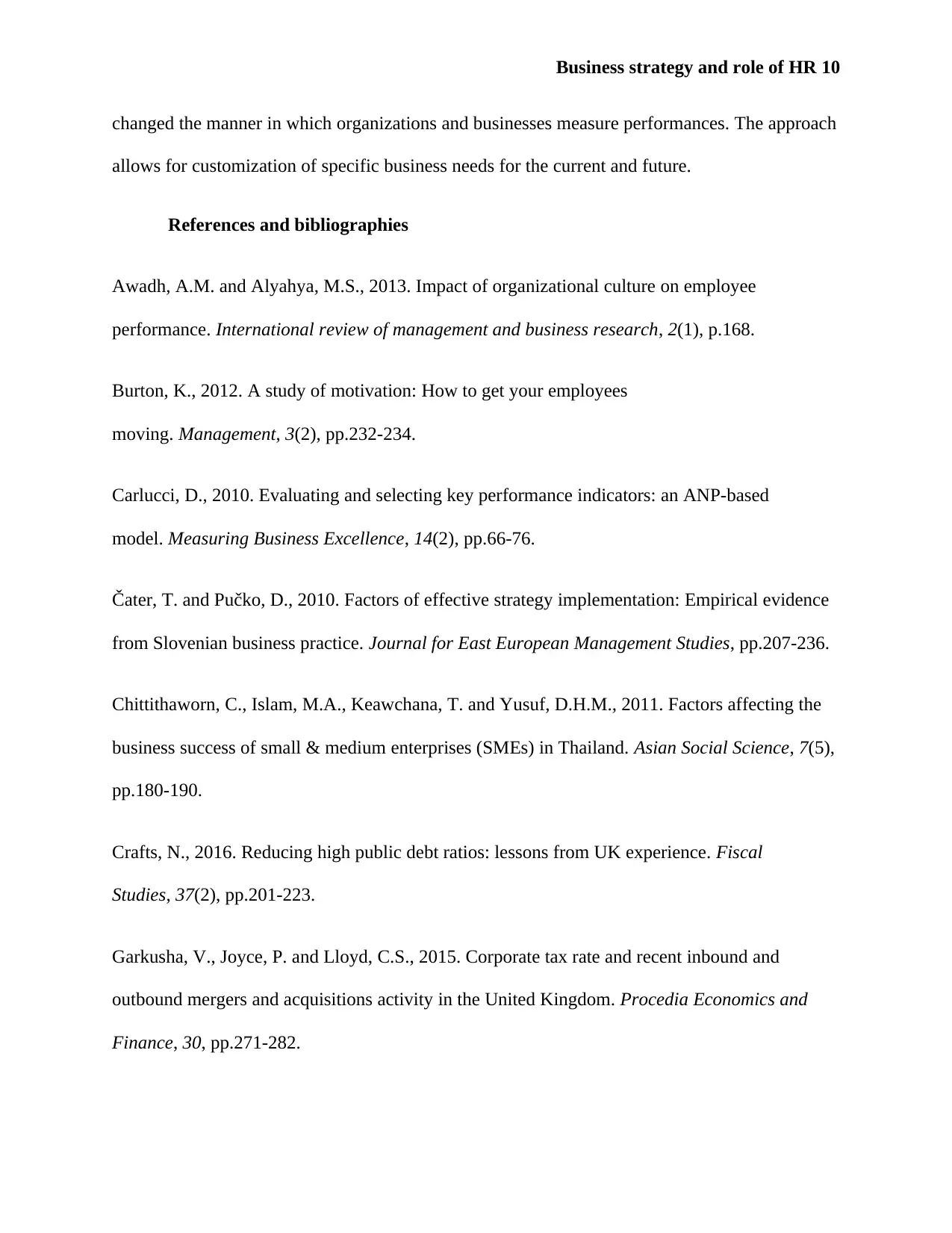
Business strategy and role of HR 10
changed the manner in which organizations and businesses measure performances. The approach
allows for customization of specific business needs for the current and future.
References and bibliographies
Awadh, A.M. and Alyahya, M.S., 2013. Impact of organizational culture on employee
performance. International review of management and business research, 2(1), p.168.
Burton, K., 2012. A study of motivation: How to get your employees
moving. Management, 3(2), pp.232-234.
Carlucci, D., 2010. Evaluating and selecting key performance indicators: an ANP-based
model. Measuring Business Excellence, 14(2), pp.66-76.
Čater, T. and Pučko, D., 2010. Factors of effective strategy implementation: Empirical evidence
from Slovenian business practice. Journal for East European Management Studies, pp.207-236.
Chittithaworn, C., Islam, M.A., Keawchana, T. and Yusuf, D.H.M., 2011. Factors affecting the
business success of small & medium enterprises (SMEs) in Thailand. Asian Social Science, 7(5),
pp.180-190.
Crafts, N., 2016. Reducing high public debt ratios: lessons from UK experience. Fiscal
Studies, 37(2), pp.201-223.
Garkusha, V., Joyce, P. and Lloyd, C.S., 2015. Corporate tax rate and recent inbound and
outbound mergers and acquisitions activity in the United Kingdom. Procedia Economics and
Finance, 30, pp.271-282.
changed the manner in which organizations and businesses measure performances. The approach
allows for customization of specific business needs for the current and future.
References and bibliographies
Awadh, A.M. and Alyahya, M.S., 2013. Impact of organizational culture on employee
performance. International review of management and business research, 2(1), p.168.
Burton, K., 2012. A study of motivation: How to get your employees
moving. Management, 3(2), pp.232-234.
Carlucci, D., 2010. Evaluating and selecting key performance indicators: an ANP-based
model. Measuring Business Excellence, 14(2), pp.66-76.
Čater, T. and Pučko, D., 2010. Factors of effective strategy implementation: Empirical evidence
from Slovenian business practice. Journal for East European Management Studies, pp.207-236.
Chittithaworn, C., Islam, M.A., Keawchana, T. and Yusuf, D.H.M., 2011. Factors affecting the
business success of small & medium enterprises (SMEs) in Thailand. Asian Social Science, 7(5),
pp.180-190.
Crafts, N., 2016. Reducing high public debt ratios: lessons from UK experience. Fiscal
Studies, 37(2), pp.201-223.
Garkusha, V., Joyce, P. and Lloyd, C.S., 2015. Corporate tax rate and recent inbound and
outbound mergers and acquisitions activity in the United Kingdom. Procedia Economics and
Finance, 30, pp.271-282.
Secure Best Marks with AI Grader
Need help grading? Try our AI Grader for instant feedback on your assignments.
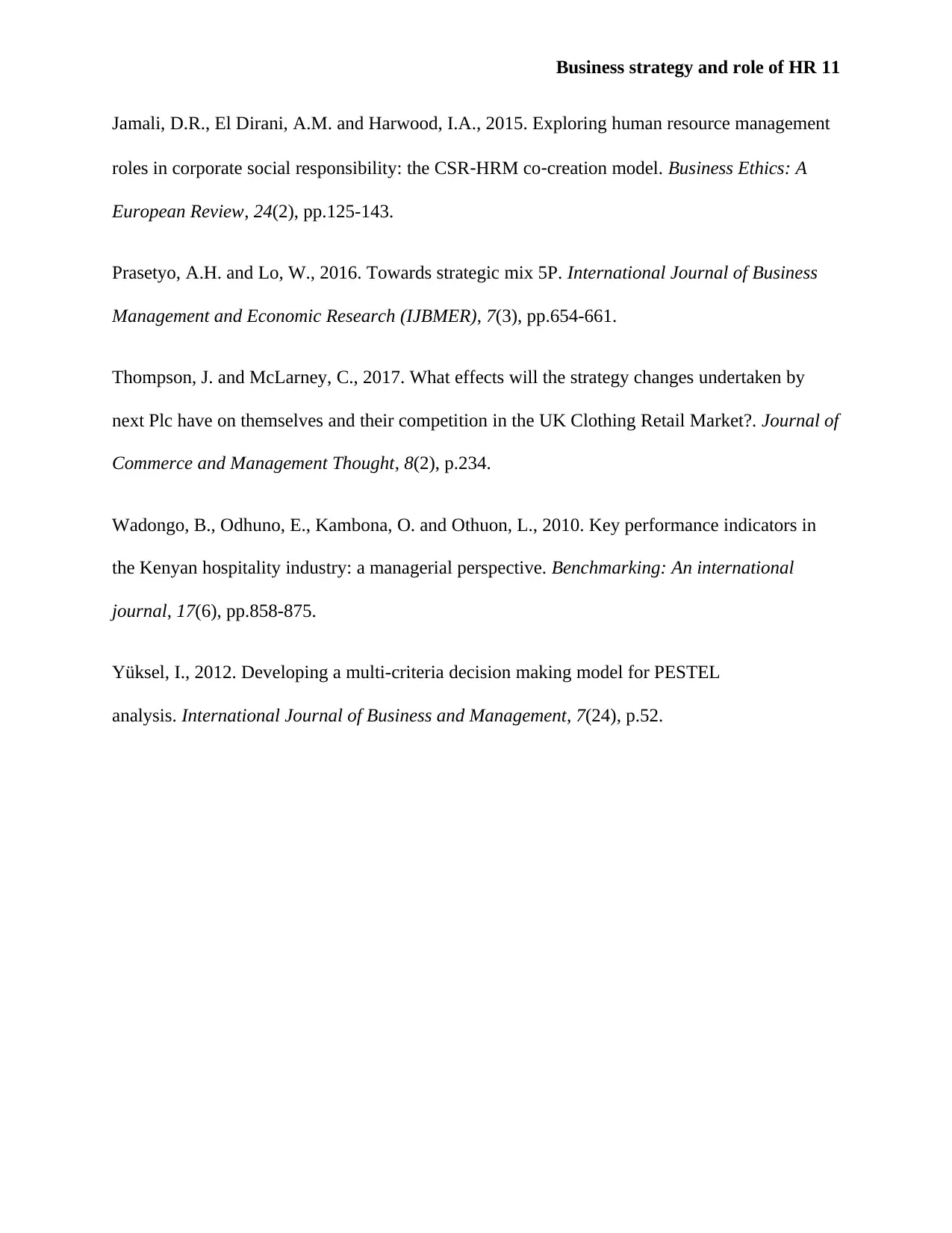
Business strategy and role of HR 11
Jamali, D.R., El Dirani, A.M. and Harwood, I.A., 2015. Exploring human resource management
roles in corporate social responsibility: the CSR‐HRM co‐creation model. Business Ethics: A
European Review, 24(2), pp.125-143.
Prasetyo, A.H. and Lo, W., 2016. Towards strategic mix 5P. International Journal of Business
Management and Economic Research (IJBMER), 7(3), pp.654-661.
Thompson, J. and McLarney, C., 2017. What effects will the strategy changes undertaken by
next Plc have on themselves and their competition in the UK Clothing Retail Market?. Journal of
Commerce and Management Thought, 8(2), p.234.
Wadongo, B., Odhuno, E., Kambona, O. and Othuon, L., 2010. Key performance indicators in
the Kenyan hospitality industry: a managerial perspective. Benchmarking: An international
journal, 17(6), pp.858-875.
Yüksel, I., 2012. Developing a multi-criteria decision making model for PESTEL
analysis. International Journal of Business and Management, 7(24), p.52.
Jamali, D.R., El Dirani, A.M. and Harwood, I.A., 2015. Exploring human resource management
roles in corporate social responsibility: the CSR‐HRM co‐creation model. Business Ethics: A
European Review, 24(2), pp.125-143.
Prasetyo, A.H. and Lo, W., 2016. Towards strategic mix 5P. International Journal of Business
Management and Economic Research (IJBMER), 7(3), pp.654-661.
Thompson, J. and McLarney, C., 2017. What effects will the strategy changes undertaken by
next Plc have on themselves and their competition in the UK Clothing Retail Market?. Journal of
Commerce and Management Thought, 8(2), p.234.
Wadongo, B., Odhuno, E., Kambona, O. and Othuon, L., 2010. Key performance indicators in
the Kenyan hospitality industry: a managerial perspective. Benchmarking: An international
journal, 17(6), pp.858-875.
Yüksel, I., 2012. Developing a multi-criteria decision making model for PESTEL
analysis. International Journal of Business and Management, 7(24), p.52.
1 out of 11
Related Documents
Your All-in-One AI-Powered Toolkit for Academic Success.
+13062052269
info@desklib.com
Available 24*7 on WhatsApp / Email
![[object Object]](/_next/static/media/star-bottom.7253800d.svg)
Unlock your academic potential
© 2024 | Zucol Services PVT LTD | All rights reserved.




